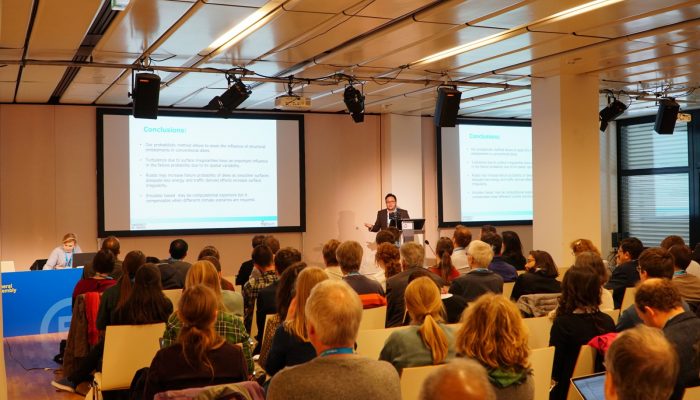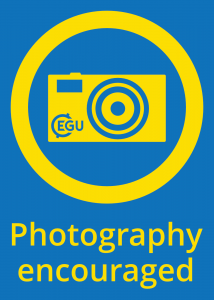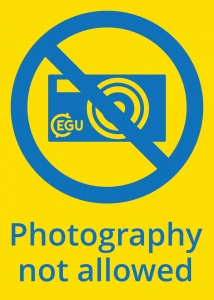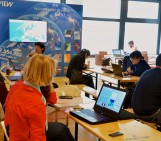
The schedule is out, presentation slots have been assigned and it’s time to start thinking about putting yours together. Whether you have an oral, poster or PICO slot, we have a suite of simple guidelines to get you ready for the conference!
Orals
The guidelines for oral presentations are online. All oral presentations should have the dimensions 16:9 or 4:3 and last about 12 minutes, with 3 minutes for questions. Oral presentations take place over four 105-minute time blocks. Make sure you’re in the presentation room approximately 30 minutes before your time block starts, so your presentation can be uploaded or so you can connect your laptop to the system. There will be a lecture room assistant to help you get everything ready.
Posters
Guidelines for poster presentations are also online. Importantly, the poster boards landscape and are 1978 mm by 1183 mm. Posters should be hung between 08:00 and 08:30 on the day of your scheduled poster presentation using tape available from roaming assistants. Please retrieve your poster at the end of the day (between 19:00 and 19:30). Those that are not collected will be disposed of. By the start of the General Assembly, EGU will have sent your Authors in Attendance Time – during this time, you must be present at your display.
If there is a gap in the corresponding oral session, conveners may call upon poster presenters to give a short ad hoc summary of their posters. Therefore, it might be useful to have a couple of slides (1-2) prepared in advance to help illustrate your findings.
PICOs
For the seventh year now we have a different kind of presentation: Presenting Interactive COntent (PICO). The guidelines for PICO presentations are available online. PICO sessions combine the best of oral and poster presentations. Every PICO author presents their slides in a “2 minutes madness”. After these short presentations, all attendees have enough time to watch the presentation again on interactive screens and hold discussions with the author and other attendees. These presentations are shown on wide-screens, so we recommend producing Power Point or PDF presentations with an 16:9 aspect ratio. However, you can also prepare your presentation in the classic 4:3 format. The extra space is then used for the branding of the contribution as well as the navigation. For 16:9 presentations, if navigation buttons are needed, our PICO staff on-site at the conference determines the position of the buttons together with you, so they don’t detract from your presentation. One thing to keep in mind is that, unlike in the past, PICO presentations no longer support Prezi.
For tips on how to make a PICO presentation, why not download the How to make a PICO guide. For a first-hand account of what it’s like to take part in a PICO session, take a look at this post by early career scientists in the Seismology Division too.
Outstanding Student Poster and PICO (OSPP) Awards
If you are presenting a poster or PICO at the upcoming General Assembly you can have your presentation considered for an OSPP Award. Check out one of our earlier blog posts to learn more on how to register yourself for the award, as well as a watch our interview with OSPP judges explaining what they look for in a winning poster.
Social media guidelines
The EGU encourages an open dialogue on social media (Twitter, Facebook, etc.) and blogging platforms during the General Assembly. The default assumption is to allow open discussion of General Assembly oral, PICO, and poster presentations on social media. However, you can request that the contents of your presentation are not disseminated on social media. The icons below may be downloaded from the EGU General Assembly website to include on slides or posters to clearly express if you do or do not want your results posted on any social media networks or blogs.
So that conference participants can embrace social media while at the same time remaining respectful of presenting authors’ work and protecting their research output, we’ve put together some social media guidelines, which you can find on the EGU 2019 website.
Time Blocks
Timetabling at the General Assembly is organised into the following time blocks:
- TB1 08:30–10:15
- TB2 10:45–12:30
- TB3 14:00–15:45
- TB4 16:15–18:00
- TB5: 18:00-19:00
There is free tea and coffee available in the poster halls in the breaks between TB1 & TB2 and TB3 & TB4. TB5 5 offers refreshments, and is dedicated to networking and additional poster viewing.
No-shows
If you already know that your abstract will not be presented, you are kindly requested to withdraw your corresponding abstract as soon as possible.





